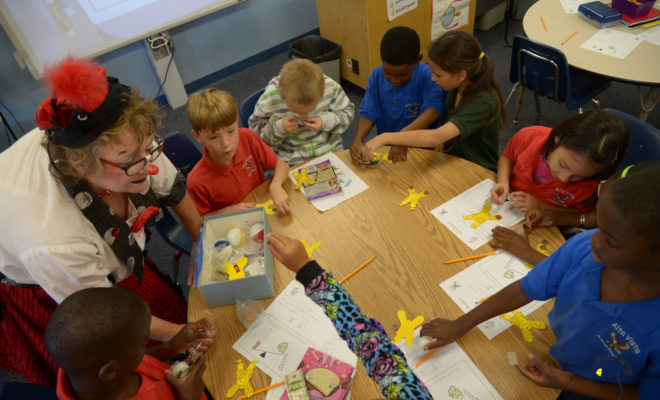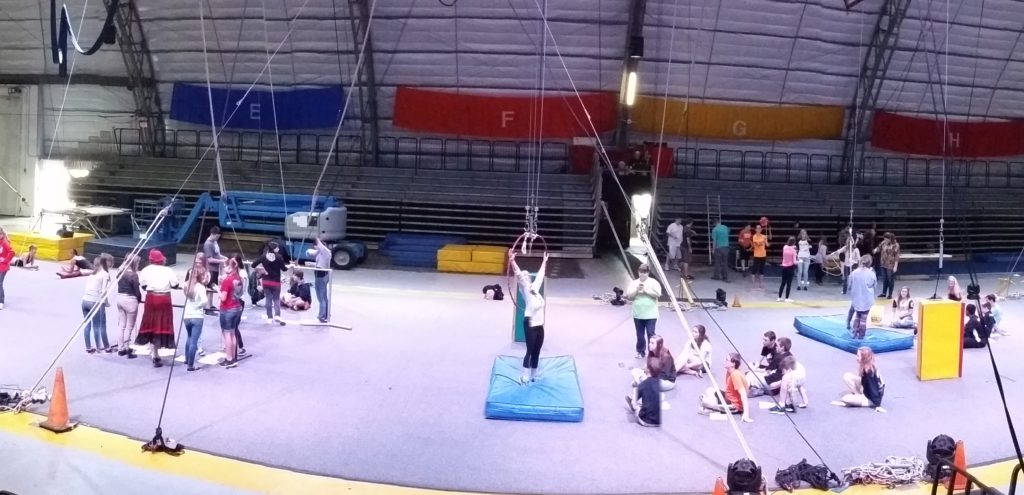
Arts & Culture
Education Matters
Circus Science Makes Learning Memorable
By Ryan G. Van Cleave
No doubt about it—if the circus world has a capital, it’s Sarasota, because that’s where John Ringling moved the Ringling Brothers Circus winter quarters back in 1927. Since then, generations of circus performers and support staff have called our community their home, forever impacting its social and economic life in profound ways.
Launched in 1997 under a different name, The Circus Arts Conservatory honors this tradition and builds on it, too, by being the only 501(c)(3) non-profit educational performing arts organization dedicated to sharing the entertainment, education, and enrichment of the circus arts in Sarasota. Their world-renowned Circus Sarasota presents annual performances in a one-ring, five-star, European-style Big Top. And the Sailor Circus Academy, America’s longest-running youth circus, is known throughout the world as “The Greatest ‘Little’ Show on Earth.”
But the most important commitment The Circus Arts Conservatory has may be its robust education and outreach efforts, which work wonders with local students and schools throughout the year. That commitment is being made easier, thanks to the $4 million renovation being done beneath the dome of the Sailor Circus Arena on Bahia Vista Street, which has housed years and years of amazing youth circus history. What’s astonishing is that the nearly seven decades of performances and educational activities have all been done without air conditioning. Thanks to private funds and a state grant, that’s going to change just in time for next year’s 70th anniversary of the Sailor Circus. But those funds are going to do more than just pay to cool the arena—they’re also going to cover the costs of replacing the current 1,500 individual chairs with retractable seating for that same audience size. In addition, they’re going to pay for new concrete flooring, and a new sprung performance floor, too. These changes will also allow people with disabilities of any type to more easily attend performances, classes, camps, and activities.
This much-needed facility upgrade has Education Manager Karen Bell feeling ecstatic. Since 2012, The Circus Arts Conservatory has instructed more than 20,000 students from 30+ elementary and middle schools. “Once we have the new facilities,” says Bell, “we’ll be better equipped to handle many, many more students. Our dream is to have every elementary and middle school participate in our educational programming.”
The circus-based classroom education programming used by Bell and fellow instructor Robin Eurich (who some might remember as Rusty the Handyman on WGN’s “The Bozo Super Sunday Show”) is based on a definition of arts integration provided by the John F. Kennedy Center for Performing Arts: “Arts integration is an approach to teaching in which students construct and demonstrate understanding through an art form. Students engage in a creative process which connects an art form and another subject area, and meet evolving objectives in both.”

For Circus Arts Conservatory teaching artists and educators, this means that they visit area schools and demonstrate circus acts, then engage with the students to better understand the relevant areas—like physics, engineering, or language arts—behind those acts.
Eurich explains that “Newtonian and Galilean physics are what students get tested on in 5th and 8th grade state assessments. But you can’t see friction, though you can see what it does. You can’t see gravity, but you can see what it does. So we try to illuminate some of these invisible concepts for students in a way that makes them memorable and understandable.” Thanks to an Education Task Force consisting of former Florida Principal of the Year Dr. Barbara Shirley, Assistant Principal of Horizons Academy Ryan Clarke, and a few other current and retired teachers, plus one former superintendent, the circus education programming is in full alignment with the state benchmarks and standards students need to pass state-wide assessments.
One of the most popular arts-integrated educational programs the team offer for grades 4-8 is The Marvelous, Miraculous, Circus Machine! Students are given curriculum booklets, hands-on project kits, and a fun classroom challenge—create a crazy, fun machine that ultimately knocks a ball into a cup. Working in teams to build their own machines, students learn firsthand—as often from failure as from success—about physics and creative problem solving. Along the way, they learn about cause and effect, gravity, force, friction, inertia, mass, and Newton’s laws of motion. But try to teach them those concepts as concepts, and you’d get groans. Do it with dominoes, balls, ramps, and string? They’re laughing and creating memories that last.
At the end of the program, the entire class is brought to the Sailor Circus Arena so students can experience a life-size version of the Marvelous, Miraculous, Circus Machine! that incorporates live circus acts as part of the process. Eurich adds that “Kids enjoy seeing how we have five or six live circus acts intertwined with the huge machine we have here. They also get the chance to see how what they’re doing in the classroom relates to the real world.” For many, too, it’s their first live circus experience.
The outcomes are more than just anecdotal. Schools that have brought The Circus Arts Conservatory teaching artists in to run programs consistently do better on testing in the areas those programs cover. That success isn’t going unnoticed—they’ve presented at the annual conferences for both the National Science Teacher Association and Florida Association of Science Teachers.
Ultimately, when learning is fun, the memories—and the lessons—stick with the students. “The other day,” says Bell, “a middle schooler ran up to me and gave me a huge hug, saying ‘Do you remember me?’ It turned out to be a student from Alta Vista Elementary who’d seen us every single year thanks to these programs. And now she saw me again in middle school and treated me like an old friend. It was awesome.”
Eurich has similar stories, such as how he was working with a class from a local Title I elementary school. In a very loud voice, one student yelled, “I can NOT do this!” Then seven seconds later, he yelled at the same volume: “I have MASTERED this!” That’s the type of unexpected and memorable learning that happens when a little dose of circus-style teaching is brought into the classroom.
For more information on The Circus Arts Conservatory, please visit www.CircusArts.org, or call 941.355.9335.
For more Education Matters, visit these posts.



You must be logged in to post a comment Login